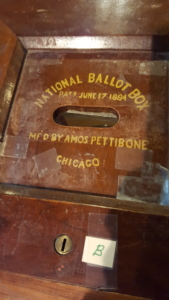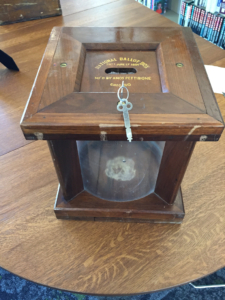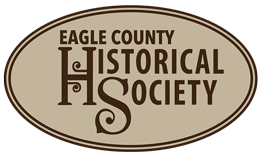Political Ingenuity: Eagle County’s First Ballot Box
Along with the delivery of ballots this week, the Eagle County Clerk’s Office and Eagle County Historical Society delivered a little bit of election history. An early day ballot box, patented in 1884, is on display in the History Department of the Eagle Public Library through election season.

The Eagle County Historical Society and County Clerk Regina O’Brien (far right) check out historic ballot boxes on display at the Eagle Library. From left are Janice Tonz, Sandy Van Campen, History Librarian Matthew Mikelson, Joanne Cermak, and O’Brien.
County Clerk’s office employees recently discovered two of the 136-year-old, wood-and-glass ballot boxes during some storeroom cleaning and handed the artifacts over to the Eagle County Historical Society. Supplementing the ballot boxes is the county’s first Voter Abstract Ledger, a large record book detailing the results of local elections from 1884 through 1924.
These artifacts and record books tell the story of a fledgling county whose citizens were eager to take on the responsibilities of democratic self-government.

The ballot box prior to cleaning and tape removal
ECHS Archivist Jaci Spuhler spent hours cleaning grime and dust off the ballot boxes and researching the history of the artifacts. Marketed as the National Ballot Box, the boxes were invented and manufactured by Amos Pettibone of Chicago in response to election corruption in San Francisco. The election-rigging involved a ballot box with a false bottom that concealed pre-marked ballots for a specific candidate. Angry voters demanded more transparency in the election process.
Pettibone figured out the solution: A locking wood frame containing a glass dome that ballots could be dropped into and observed constantly. Opening the box to reach the ballots involved undoing three locks with several different keys. Citizens could watch the voting process and be certain of the results.
Give those early day Eagle County commissioners credit for investing in state-of-the-art election equipment. Two much simpler locking wooden box ballot boxes, probably decades younger than the National Ballot Boxes, were also donated to the Historical Society. The homemade hinged boxes with a ballot drop slot and a latch designed for a padlock probably reflect the frugality of a budget-conscious county clerk and Board of Commissioners.
The ballot boxes will ultimately be displayed in the Eagle County History Museum.
The Voter Abstract book is archived at the Eagle Public Library, which partners with the ECHS in making historic records accessible to the public. That book too reveals some interesting bits of local history. For example, 306 ballots were cast in the county’s first election on Nov. 4, 1884. There were nine voter precincts in the county, including the mining camps of Taylor Hill, Mitchell, Red Cliff, Cleveland (Gilman), Rock Creek and Dotsero. The agricultural precincts were Sheephorn, Brush Creek and “Lakes” (Edwards). Minturn, Avon, Eagle and Gypsum are not part of the picture until a few years later.
The ledger book also reveals the county’s steady population growth, settlement patterns and social trends. In 1893, when Colorado gave women the vote, Eagle County was on board, voting 415 – 257 in favor of women’s suffrage.
Voter registration was also a much different process in 1899. An article in the Eagle County Blade (Red Cliff) newspaper on Oct. 19, 1899 indicates that every precinct had its own Voter Registration Board, and notes that people registering to vote needed to be vouched for via affidavits from two already registered voters. “Voters should personally see that they are registered as very often names are overlooked by the boards,” advised the newspaper.
Eagle County’s first historic ballot box will be on display on the second floor of the Eagle Library through election day. Stop by to take a look. Consider it a reminder to cast those 2020 ballots. The Voter Abstract ledger can be viewed upon request to the library’s History Department.

This ingenious ballot box design ensures that the voting process is transparent, and that the ballots cannot be tampered with without considerable effort.
Researched and submitted by Kathy Heicher.
October, 2020
